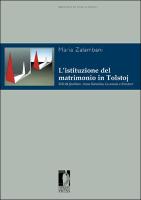L’istituzione del matrimonio in Tolstoj
Felicità familiare, Anna Karenina, La sonata a Kreutzer
| dc.contributor.author | Zalambani, Maria | |
| dc.date.accessioned | 2022-05-31T10:25:06Z | |
| dc.date.available | 2022-05-31T10:25:06Z | |
| dc.date.issued | 2015 | |
| dc.identifier | ONIX_20220531_9788866557562_548 | |
| dc.identifier | OCN: 1226009525 | |
| dc.identifier.issn | 2612-7679 | |
| dc.identifier.uri | https://library.oapen.org/handle/20.500.12657/55264 | |
| dc.language | Italian | |
| dc.relation.ispartofseries | Biblioteca di Studi Slavistici | |
| dc.title | L’istituzione del matrimonio in Tolstoj | |
| dc.title.alternative | Felicità familiare, Anna Karenina, La sonata a Kreutzer | |
| dc.type | book | |
| oapen.abstract.otherlanguage | Leo Tolstoy's works are not only masterpieces of world literature, but also mirrors of their time, of the socio-cultural transformations which took place in Tsarist Russia; it is from this perspective that, in this work, this great writer’s production is analysed. In particular, the author examines the evolution of the institution of marriage in the second half of the 19th century in Russia, starting from the reading of Family Happiness , Anna Karenina and The Kreutzer Sonata. If Family happiness preludes to the crisis of the arranged marriage, its implosion is beautifully described in Anna Karenina . Anna announces the definitive death of this institution when she defies the society of her time by not hiding her adultery and, on the contrary, by exhibiting it and trying to legitimize it.The Kreutzer Sonata, lastly, demonstrates the successful overcoming of the aristocratic marriage model, replaced by the bourgeois one. | |
| oapen.identifier.doi | 10.36253/978-88-6655-756-2 | |
| oapen.relation.isPublishedBy | bf65d21a-78e5-4ba2-983a-dbfa90962870 | |
| oapen.relation.isbn | 9788866557562 | |
| oapen.relation.isbn | 9788866557555 | |
| oapen.relation.isbn | 9788892733763 | |
| oapen.series.number | 27 | |
| oapen.pages | 210 | |
| oapen.place.publication | Florence |

